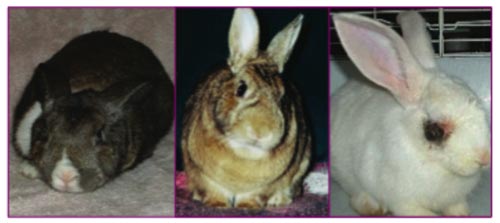Abcesses in Rabbits
Abscesses are one of the most commonly seen disorders in pet rabbits. Abscesses are collections of pus (bacteria, white blood cells, and cellular debris) that can occur for a variety of reasons. Rabbit abscesses are very different from those that occur in cats and dogs. Cat and dog abscesses usually result from bite wounds. They grow quickly, usually cause fevers, and are characterized by liquid pus. Rabbit abscesses can be secondary to wounds, but are usually associated with underlying disease. They grow slowly, usually do not cause fevers, and are much more difficult to treat. Rabbits are very good at walling off their abscessesfrom the rest of their body with a thick fibrous capsule. Rabbits form thick, toothpaste-like pus which makes their abscesses almost impossible to drain. Although abscesses can occur anywhere in the body, most occur on the face or the feet. Facial abscesses are usually associated with dental disease, while foot abscesses are associated with ulcerative pododermatitis (sore hocks).
A thorough physical exam should be performed in order to assess a rabbit’s overall health and uncover any potential underlying problems. A veterinarianwill ask lots of questions about what the rabbit is fed, how he is housed, and whether there is any history of other medical problems. Abscesses can usually be diagnosed by feel. Sometimes rabbits can have other lumps and bumps. If there is any uncertainty, a veterinarian can insert a needle into the lump (called a fine needle aspirate) to determine whether there is pus inside. Dental exams are routinely performed. Many rabbits resist evaluation of their teeth, and sometimes anesthesia is required. Radiographs (x-rays) can also be helpful in assessing tooth problems, and determining if the abscess has spread to involve the nearby bone. Blood work may be recommended for some rabbit patients.

(Left): Duke had a huge abscess under his chin. It was attached to his jaw bone and ruined several molars.
(Center): Hugo had an iris abscess. Antibiotics were tried, but things got worse. Unfortunately the eye had
to be removed. (Right): Flash was found as a stray with a severely infected eye with a ruptured retina.
Unfortunately his eye also needed to be removed.
Most people think of Pasteurella when they think of rabbit abscesses. Pasteurella is a bacteria that can live in a rabbit without causing disease. It can, however, cause lots of problems from respiratory infections (snuffles) to ear infections. While Pasteurella is frequently isolated from rabbit abscesses, it is not the only organism known to cause problems in bunnies. Other bacteria that have been found in abscesses include Staph, Pseudomonas, Proteus, and Bacteroides. A veterinarian will likely recommend that a sample be submittedfor culture and sensitivity testing. This is an incredibly useful test that allows the vet to figure out which bacteria are causing the problem, and what antibiotic is most likely to be successful in treating the abscess.
Medical approaches are varied. Antibiotics are always warranted, and are often used long term. Rabbits are notoriously sensitive to many different kinds of antibiotics, and they must be chosen wisely. Commonly used antibioticsinclude enrofloxacin (Baytril), trimethoprim-sulfa (Bactrim), chloramphenicol, and metronidazole (Flagyl). Antibiotics that are commonly avoided when used orally, like cephalosporins or penicillin, can be given injectably to rabbits with abscesses. As with any medication, rabbits on long term antibiotics should be closely monitored for potential side effects. Unfortunately, recurrence is common even with long term therapy.
The treatment of choice for abscesses in rabbits is surgery. In general, abscesses are treated as if they were tumors. Many times the entire abscess and capsule can be surgically removed. Even when surgery goes perfectly, there is a good chance that an abscess will recur. Sometimes it is not possible to surgically remove an abscess, as is often the case with foot and jaw lesions. Other surgical approaches may include implanting antibiotic impregnated beads, gauze, or specific types of dental material into the infected site. With some severe foot abscesses, amputation is often the best alternative. Rabbits can do remarkably well with 3 legs.
Some abscesses are treated topically. They may be flushed with disinfectants like chlorhexidene or iodine. Some veterinarians use strong sugar solutions or honey to manage infections, with frequent re-evaluation of the abscess site. Some wounds can be treated topically with silver sulfadiazine (Silvadene), while others are bandaged to facilitate healing. Alternative therapies may include herbal medications, acupuncture, orphysical therapy (especially useful if the feet are involved).
Rabbit abscesses can be time consuming and expensive to treat. Veterinarians experienced in rabbit medicine can evaluate each rabbit on an individual basis, and provide the best options for treatment. The prognosis for rabbit abscesses can be varied, but sadly, many rabbit abscesses are resistant to treatment. In some cases, euthanasia may be the best option.
by Jacqueline Warner, DVM
